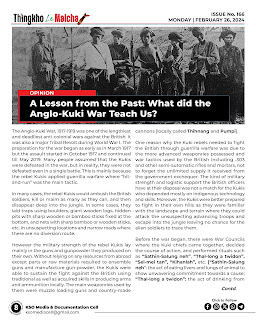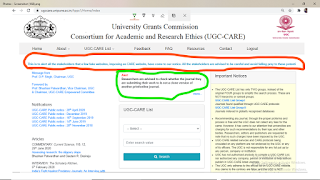A Lesson from the Past: What did the Anglo-Kuki War Taught Us?
The Anglo-Kuki War, 1917-1919 was one of the lengthiest and deadliest anti-colonial wars against the British. It was also a major Tribal Revolt during World War I. The preparation for the war began as early as in March 1917 but the assault started in October 1917 and continued till May 1919. Many people assumed that the Kukis were defeated in the war, but in reality, they were not defeated even in a single battle. This is mainly because the rebel Kukis applied guerrilla warfare where “hit-and-run” was the main tactic.
In many cases, the rebel Kukis would ambush the
British soldiers, kill or maimed as many as they can, and then disappear deep
into the jungle. In some cases, they laid traps using boulders, giant wooden
logs, hidden pits with sharp wooden or bamboo sticks fixed at the bottom, and
nets with sharp bamboo or wooden sticks, etc. in unsuspecting locations and
narrow roads where there are no diversion routes.
However the military strength of the rebel Kukis
lies mainly in the guns and gunpowder they produced on their own. Without
relying on any resources from abroad except parts or raw materials required to
ensemble guns and manufacture gun-powder, the Kukis were able to sustain the
fight against the British using traditional as well as acquired skills in
producing arms and ammunition locally. The main weaponries used by them were
muzzle loading guns and country-made cannons [locally called Thihnang
and Pumpi].
One reason why the Kuki rebels needed to fight the
British through guerrilla warfare was due to the more advanced weaponries
possessed and war tactics used by the British including .303 and other
semi-automatic rifles and mortars not to forget the unlimited supply it
received from the government exchequer. The kind of military strength and
logistic support the British officers have at the disposal was not a match for
the Kukis who depend mostly on indigenous technology and skills. Moreover, the
Kukis were better prepared to fight in their own hills as they are familiar
with the landscape and terrain where they can attack the unsuspecting advancing
troops and escape into the jungle leaving no chance for the alien soldiers to
trace them.
Before the war began, there were War Councils where
the Kuki chiefs came together, decided the course of action, and performed
rituals such as "Sathin-Salung neh", “Thal-long a twidon”,
“Sel-mei tan”, "Kihanlah", etc. ["Sathin-Salung
neh": the act of eating livers and lungs of animal to show unwavering
commitment towards a cause; “Thal-long a twidon”: the act of drinking
from the barrel of a gun to show that they will not retreat even at the point
of death; “Sel-mei tan”: cutting the tails of Mithun as a sign of being
the rightful authority, chiefship, or show of valour and courage; "Kihanlah":
Kukis way of performing war cry as an act of taking a vow, building confidence
and dispelling fear, if any]. In the process, commanders for each division
(hills or areas) were also decided. Here, most of the leaders so appointed were
naturally the powerful chiefs of the respective areas but some of them such as
Enjakhup were common man chosen purely on merit because of their personality
and experience as a former military man in the British government. This shows
that the Kuki chiefs, who possessed self-sacrificing and deep sense of
patriotism, were usually “born leaders” and “organisers” of such rebellion but
it was not the monopoly of the hereditary chiefs to lead a war front.
While reading the Anglo-Kuki War, many tend to focus
on the role of the chiefs alone. But the contribution of the womenfolk was not
lesser. They were the driving force behind the menfolk who were in the
battlefield by taking care of the dependants (children, elderly, and the sick)
including those injured. The women were also responsible for preparing
ingredients required for pounding gun-powders and in manufacturing guns. Even naang
(tender bamboo splits mean for binding) or khaopi (wild rope),
sharpened bamboo and wooden sticks, and other materials needed for laying
traps, etc. were often arranged by the womenfolk. They also took the
responsibility of cooking and arranging lunch-packs and tobaccos which they
were fond of for the fighters who were on ambush sometimes for days together.
However, despite their best efforts, the Kuki chiefs
had to finally submit to the colonial government, not out of fear or defeat,
but compulsion necessitated by lack of food supply and other essential items
needed to sustain the war particularly to feed their dependants. This was the
result of various factors ingeniously applied by the British of which one of
the most important was the warfare on the economic front.
Perhaps the British initially thought that the Kuki
tribals wouldn’t sustain the “rebellion” for long. But they soon realised that
they have miscalculated the strength of the Kuki rebels, and hence changed the
strategy in the second phase. As they couldn’t subdued the Kukis in the first
year, they focus on destroying their villages and huts, seeds and crops, cattle
and other domesticated animals, water sources and road-connections, and such
other essential items required for a living in the “hostile” villages. They
also ruined their jhum fields by burning them before it was the
right time to do so. So, after the end of the second year, as the wild foods
and those harvests usually left in jhum fields were exhausted,
the Kukis were left with practically nothing to survive for another year.
Moreover, as the Kukis from the “hostile” villages
have been living in the jungles for years, epidemics and diseases have
overwhelmed them. To make their condition worse, they were no longer able to
prepare enough medicines and perform medical treatment for the sick and
injured. Pregnant and lactating women and the new-born child were also
struggling to survive under cold and rain in the jungle. Over and above, they
felt worst of in the spiritual realm as they were unable to perform fitting
funeral rituals for the deaths! It shouldn’t be forgotten that one of the
reasons why the Kukis refused to go to France as part of the “labour corps” was
the fear that they might not be able to perform death rituals in case they die
beyond the sea. According to the Kukis’ beliefs, if necessary rituals are not
performed for a dead body, the soul will not be able to cross the “mithi-kho”
(village or valley of the deaths), but remained in perpetual servitude in the
life after death.
All these factors, and many more, compelled the Kuki
chiefs to surrender to the authority after nearly three years of revolt. During
this whole period, they were neither exhausted nor demoralised to endure the
sufferings due to the war. In fact, the will to fight was as strong as it was in
the beginning. Yet they can’t also ignore the plights of the innocent women,
children and the elderly. Above all these, the inducements offered by the
government such as reconstruction of villages; supply of food for free, or with
minimal taxes for a year; distribution of seeds for agriculture; leniency for
surrendered chiefs, and the like, were too tempting to refuse.
However, the surrendered spree did not take place
before the government lost a huge amount of money and a good number of soldiers
and coolies in its attempt to suppress the rebellion. The military operations
with “continuous active service in mountainous country” was carried out by the
combined forces of Assam and Burma Military Police involving 6234 combatants,
696 non-combatants, 7650 transport carriers among others. It was the “largest
series of military operations” in the eastern frontier of India, eclipsed only
by World War II in the region in 1944. These whole operations cost a staggering
rupees 28 lakhs to the government exchequer!
Moreover, casualties on the British troops include
60 deaths (including a British officer), 142 wounded (including 3 British
officers), and 97 deaths due to diseases. Interestingly, only seven coolies
were killed by the rebels, a figure which could have been higher had the
targets included them, though many more died of diseases. The total number of
deaths (most of which were due to epidemic and diseases) was 393. On the other,
official estimates of Kukis killed during the operations stands at 120 though
the figure was much less from the Kukis’ version.
Regarding livestock and properties destroyed or
looted, the official record says 576 mithuns (possibly much higher than this)
along with a large number of cattle, goats, pigs, fowls, etc. Moreover, 126
Kuki villages were completely burnt down, 16 declared permanently barren or
deserted, and 140 coerced to surrender. No official estimate was available on
the amount of food-grains and other materials such as rice, root crops,
vegetables, oilseeds, cotton, beans, etc., systematically destroyed or looted
from the village granaries and “hidden stores” in the jungles. Considering the
tiny population size of the Kukis then, the amount of properties destroyed was
unimaginable.
To condense the long history short, there are many
lessons we can learn from the Anglo-Kuki War to sustain the ongoing ethnic
cleansing campaign perpetrated by the dominant community to crush the Kukis,
but the following two questions are worth pondering over at the moment:
First,
are we in a position to sustain the war effort economically beyond three years
as our forefathers did?
Second,
are our leaders in a position to decline anything other than separation from
the “hegemony of majoritarian politics” if the state offers us a condition so tempting?
Let us not forget the last-hour agreement signed
following the 123-days agitation for Sadar Hills district in 2011 which many of
us fondly remembered as the “mid-night agreement”. During the course of that
agitation, three precious lives were lost in an unfortunate incident, and huge
amounts of money and resources were pulled-in not to forget the invaluable
contributions of those injured in police actions, volunteers on duty, hunger
strikers, and donors and well-wishers in and around the world.
In this ongoing ethnic war, the brave Kuki warriors
in the frontline will not retreat even in the face of death. As Pu Paolienlal
once tweeted, _“Every Kuki will give their lives to be free from the hegemony
of majoritarian politics,”_ but we are all human beings with emotions.
Therefore, unless our frontline warriors are shown the minimal moral as well as
material support needed for a soldier, they can lose the spirit to bear heat
and cold under incriminating weather.
By the way, how’s the josh, Dear Leaders!
(Courtesy: KSO Bulletin Thingkho le Malcha,
Issue No.166, February 26, 2024).




Comments
Post a Comment